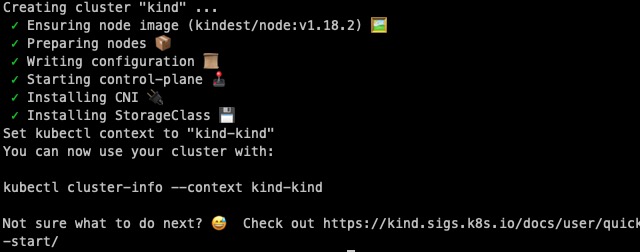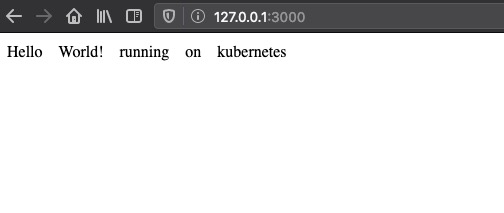使用kind构建一个单层架构Node/Express网络应用程序
Kubernetes实战-从零开始搭建微服务 1
前言
准备写一个Kubernetes实战系列教程,毕竟cnblogs作为国内最早的技术博客现在都已经开始迁移到Kubernetes了,此处要有掌声给博客园。系列会更加偏向于实战,对于理论只在需要时讲解。
Docker hub 上我个人觉着有两个做奇葩的镜像image
- dind, docker in docker
- kind, kubernetes in docker / k8s in docker
很多人对k8s的学习都是从minikube开始,但是,但是,但是,当你亲身对比kind和minikube的时候,会发现kind至少速度快三倍(在我这台mac老本上)。
1 准备
需要提前安装好
- docker
- kubernetes-cli
安装kind
mac
brew install kind
linux
curl -Lo ./kind https://kind.sigs.k8s.io/dl/v0.8.1/kind-$(uname)-amd64 chmod +x ./kind mv ./kind /some-dir-in-your-PATH/kind
windows 参考kind官方指南
试试运行kind --version确保kind的安装正确。
2 创建第一个cluster
需要大概2~3分钟, kind create cluster
会创建一个cluster 名字为kind-kind
kubectl cluster-info 了解下cluster 状况
Kubernetes master is running at https://127.0.0.1:51842
KubeDNS is running at https://127.0.0.1:51842/api/v1/namespaces/kube-system/services/kube-dns:dns/proxy
To further debug and diagnose cluster problems, use 'kubectl cluster-info dump'.
其中的链接即使你的k8s control plane
如果再运行docker ps, 至少会有一个kind-control-plane 的container 在运行。
可以再试试以下命令:
kind get clusters获取所有clusterkubectl config get-contextskubectl get nodes -o widekubectl get svc
截止目前,一个单节点的k8s集群就在本地的docker环境里搭建好了。👌
3 发布一个node/express app
创建以下文件,并保存。
Dcoker and App
inde.js
const express = require('express') const app = express() const port = 3000
app.get('/', (req, res) => res.send('Hello World! running on kubernetes'))
app.listen(port, () => console.log(
Example app listening at http://localhost:${port}))
package.json, package-lock.json 整个项目文件,请访问github repo
Dockerfile
FROM node:14.2.0-alpine EXPOSE 3000 WORKDIR /anode
ADD package.json . ADD package-lock.json .
RUN npm ci ADD . .
CMD ["node", "index.js"]
上传镜像到docker hub (可选)
克隆所有需要的代码和配置文件。 在push镜像之前,不要忘了docker login。
docker build -t {yout dockerhub name}/a-node:v1 .
docker push {yout dockerhub name}/a-node:v1
deployment, service 配置
deployment.yaml
apiVersion: apps/v1 kind: Deployment metadata: name: a-node-deployment labels: app: node spec: replicas: 1 selector: matchLabels: app: a-node template: metadata: labels: app: a-node spec: containers: - name: a-node-container image: tim010/a-node:v1 # or your own image ports: - containerPort: 3000
service.yaml
apiVersion: v1 kind: Service metadata: name: a-node-service spec: ports: - targetPort: 3000 protocol: TCP port: 80 selector: app: a-node-service type: NodePort
发布
kubectl apply -f deployment.yaml
deployment.apps/a-node-deployment created
kubectl apply -f service.yaml
service/a-node-service created
为了确保发布成功,运行
kubectl get pods
应该会输出如图的结果,不要忘了复制你的pod名。
kubectl get service
NAME TYPE CLUSTER-IP EXTERNAL-IP PORT(S) AGE
a-node-service NodePort 10.111.52.71 <none> 80:32709/TCP 7h25m
kubernetes ClusterIP 10.96.0.1 <none> 443/TCP 8h
等等,即使发布成功了,我的app在哪呢?
http://10.111.52.71:3000?localhost:3000- no
你需要端口转发
kubectl port-forward {your port name for deployment 你的pod名} 3000:3000

取消发布 teardown
kubectl delete -f deployment.yml
kubectl delete -f service.yml
停掉整个cluster
kind delete cluster
结束语
至此,你的本地k8s 集群生命终结。
动手去做永远都会比只学习理论要快得多,希望这第一个教程可以让大家都快速上手,不被K8s复杂的概念吓到。系列后续会写一些更多关于Kubernetes 高可用性 和架构的。
Tips 小提示
- kind 推荐docker 内存设置最少为6G, 亲测,低于6G在mac 2018 上依然可用。
- docker 在mac 上有一点不同,网络上docker desktop mac 有不少恼人的限制
- 如果docker hub访问受限,请尝试国内大厂节点
源码,参考和推荐
- github repo源码
- kind
- 张晋涛博客 kind的开发者之一















